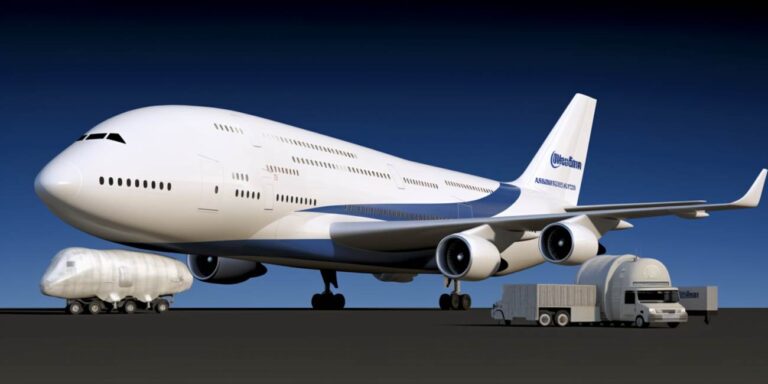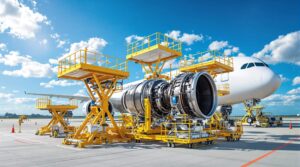Let’s delve into the specifics of these titans, starting with the Airbus Beluga. This distinctive aircraft, named after the white whale due to its bulbous and expansive upper fuselage, serves as Airbus’s dedicated transporter for large aircraft components. The Beluga is a modified version of the Airbus A300, featuring an enlarged cargo bay that can accommodate massive sections of airplanes, including wings and fuselage sections.
On the other side of the spectrum, we have the Boeing Dreamlifter, a colossal freighter designed to transport Boeing’s largest components, primarily supporting the Boeing 787 Dreamliner production. The Dreamlifter boasts a unique swing-tail design, allowing for efficient loading and unloading of oversized cargo. It is an essential player in Boeing’s logistical chain, ensuring the timely delivery of crucial aircraft sections.
When comparing these aerial giants, size is a paramount factor. The Airbus Beluga has a payload capacity of around 47 metric tons and a range of approximately 2,780 kilometers. In contrast, the Boeing Dreamlifter outshines its competitor with a colossal payload capacity of about 113 metric tons and an impressive range of 4,200 kilometers. This significant disparity positions the Dreamlifter as the heavyweight champion in terms of sheer cargo capacity and reach.
Maneuverability is another critical aspect, and here, the Airbus Beluga showcases its agility. The aircraft is designed for short and medium-haul routes, allowing it to navigate through various airports efficiently. In contrast, the Boeing Dreamlifter, with its long-range capability, excels in covering vast distances, making it the preferred choice for international transport of oversized components.
While both aircraft serve similar purposes, their unique designs and capabilities cater to the specific needs of their respective manufacturers. The Airbus Beluga excels in intra-European transport, seamlessly integrating into Airbus’s production network. Simultaneously, the Boeing Dreamlifter operates on a global scale, facilitating the intricate supply chain required for Boeing’s international production hubs.
Size comparison of these remarkable transport aircraft
When it comes to remarkable transport aircraft, size matters. These colossal flying machines are engineering marvels that play a crucial role in global logistics and military operations. Let’s delve into a size comparison of some of the most noteworthy transport aircraft, showcasing their immense dimensions and capabilities.
First on our list is the venerable C-5M Super Galaxy, a strategic airlift behemoth that stands as one of the largest military aircraft globally. With a wingspan of 68.8 meters and an overall length of 75.5 meters, the C-5M can carry a staggering cargo load of 122,500 kilograms. Its distinctive nose can be raised to allow for “drive-on/drive-off” vehicle loading, adding to its versatility.
Next, we have the iconic Lockheed C-130 Hercules, a tactical airlift workhorse renowned for its versatility. While not as colossal as the C-5M, the C-130 still boasts impressive dimensions. With a wingspan of 40.4 meters and a length of 29.8 meters, this aircraft can carry a payload of up to 19,051 kilograms. Its ability to take off and land on short and unpaved runways makes it invaluable in various military and humanitarian missions.
Turning our attention to the commercial sector, the Antonov An-225 Mriya stands out as the largest cargo aircraft globally. This Ukrainian giant holds the record for the heaviest payload ever transported by air. With a colossal wingspan of 88.4 meters and an overall length of 84 meters, the An-225 is a true giant of the skies. Its maximum takeoff weight is an astounding 640 metric tons, showcasing its unparalleled capacity.
For maritime patrol and anti-submarine warfare, the Boeing P-8 Poseidon is a notable entrant. While not as massive as some cargo planes, its dimensions are impressive for its specific role. The P-8 has a wingspan of 37.6 meters and a length of 39.5 meters. Its state-of-the-art mission systems and long-range capabilities make it a vital asset for naval operations.
Concluding our size comparison, it’s clear that transport aircraft come in various sizes, each tailored to fulfill specific mission requirements. Whether it’s the colossal cargo capacity of the C-5M Super Galaxy, the tactical versatility of the C-130 Hercules, the record-breaking capabilities of the Antonov An-225 Mriya, or the maritime prowess of the Boeing P-8 Poseidon, these aircraft showcase the incredible diversity and innovation in aviation engineering.
History of Boeings
Boeing’s rich history is deeply intertwined with the evolution of aviation itself. The company, founded in 1916 by William Boeing, played a pivotal role in shaping the aerospace industry. Over the years, Boeing has become synonymous with cutting-edge technology and innovation.
When it comes to the construction of Boeing aircraft, precision and engineering excellence take center stage. The process involves meticulous planning, utilizing state-of-the-art materials, and adhering to rigorous quality standards. Each aircraft is a marvel of modern engineering, reflecting Boeing’s commitment to pushing the boundaries of what is possible in aviation.
One of the key aspects of Boeing’s manufacturing process is the transportation of parts. Various components, ranging from fuselage sections to wings and engines, are crafted with utmost precision at different facilities. These parts then embark on a journey across the globe to reach the final assembly line. The coordination involved in this logistical ballet is a testament to Boeing’s global presence and seamless integration of its supply chain.
The heart of Boeing’s operations lies in the meticulous assembly of these parts into fully functional aircraft. The assembly process is a symphony of human expertise and advanced robotics. Skilled technicians work alongside cutting-edge machinery to bring together the various components, ensuring that each aircraft meets Boeing’s stringent safety and performance standards.
To delve into the specifics, let’s look at a simplified breakdown using a table:
| Stage | Description |
| Construction | The initial phase involving the fabrication of aircraft components with precision engineering. |
| Transportation of Parts | Efficient logistics ensure the smooth movement of aircraft parts from manufacturing facilities to assembly lines. |
| Assembly | The final stage where skilled technicians assemble various components to create a fully functional Boeing aircraft. |
This simplified overview only scratches the surface of Boeing’s intricate processes. The company’s commitment to excellence in construction, seamless transportation of parts, and precise assembly has positioned it as a global leader in the aerospace industry.
Interesting facts about Airbus a320 and boeing 737
The rivalry between Airbus A320 and Boeing 737 in the aviation world has been nothing short of legendary. These aircraft have not only redefined air travel but also set numerous records that showcase their exceptional capabilities.
When it comes to performance, both the Airbus A320 and Boeing 737 stand out in their own right. The A320, known for its innovative fly-by-wire technology, provides a smooth and efficient flying experience. On the other hand, the Boeing 737, with its timeless design, has been a workhorse in the aviation industry, delivering reliable performance across the globe.
Let’s delve into some intriguing records held by these aviation giants. The Airbus A320 family, with its A320neo model, boasts the title of the quietest single-aisle aircraft. This remarkable feat not only enhances the passenger experience but also addresses environmental concerns.
Boeing 737, on the other hand, takes pride in its long-standing reputation as the best-selling commercial jetliner in history. This record speaks volumes about its widespread adoption and unwavering popularity among airlines worldwide.
Turning our attention to price, it’s interesting to note that the Airbus A320 and Boeing 737 compete not just in performance but also in cost-effectiveness. Airlines often weigh the price of these aircraft against their unique features and operational efficiency to make strategic decisions for their fleets.
As we compare the prices of these aircraft, it becomes evident that both Airbus and Boeing offer competitive options. The A320, with its modern design and fuel-efficient engines, aims to provide an economical choice for airlines. Meanwhile, the Boeing 737, with its legacy and continuous innovations, seeks to maintain a balance between performance and price.
It’s worth noting that the battle between Airbus A320 and Boeing 737 goes beyond records, performance, and price. Each aircraft has carved its niche in the aviation industry, attracting airlines based on their unique strengths and features.






